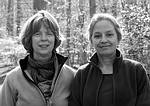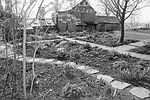Partners in Abundance
Neal Harris and Cellen Wolk, friends, collaborators and business partners of Hey Hoe Garden Design, love abundance. Lushness, Neal explains. Cellen’s mother and aunts were obsessive gardeners, as were their neighbors. They worked in each other’s yards, doing radical things, experimenting together. Her mother has always lived in New England and has had New England gardens. Her delphiniums grow to 8 feet. “You don’t see that here,” Cellen says “so I have adapted.”
Neal’s first inspiration came from her father who raised vegetables. Gardening makes her feel connected to him. Her grandmother, a nature lover, gave her Flowers in Shakespeare’s Garden when she was a child. Neal grows passionate when she explains how her collaboration with Cellen is her real inspiration. In collaboration, she says, you see things you never would have alone.
Neal and Cellen began their partnership in 1995 when they were both working for another landscape designer. They realized that they both wanted to garden professionally, they were kindred spirits, they had plant sense and design sense, and most importantly, that they actually could do it.
They thrive on word of mouth. Neal says they know three quarters of the psychotherapists in Westchester. Their original Westchester client belonged a number of women’s groups and book clubs who met in her house. Cellen asks Neal, “Am I exaggerating when I say we got 20 jobs from her?” Neal answers, “Probably, but we did get a lot.”
Neal and Cellen have a synergistic relationship. Neal pays more attention to detail and Cellen is more likely to drive a project to completion. On one job, for example, they had planted two different shrubs that bloomed white at the same time, but they weren’t the same shade of white and the purer white blossoms made the other look dirty. It wasn’t something the client had noticed, and it would have been easy enough to let it slide. However, Neal couldn’t let it rest so they changed one shrub for another and now the combination is beautiful.
Both women have a good eye and they rely on each other to see what is possible in a landscape. Their ideas are often very different; Cellen tends to the practical, how to solve a problem like drainage or screening; Neal to the fine points and unusual plant selection. “If Neal likes one of my ideas,” says Cellen, “I’m confident it’s good.”
They are both interested in challenges, and they stay with their clients to see how their properties do throughout the seasons and over time. For example, they have a client who had placed his Jacuzzi in the dead center of his yard. The house was built of weathered materials and copper, brick and slate. The challenge was to soften the environment and to give him privacy. Cellen tells how they had put in shrubs and plantings and that they had accentuated the interesting textures of the house by leaving the foundation bare.
Neal nods her head in agreement but looks thoughtful as though something just occurred to her and says, “I think he could have a very low soft bed around the house, don’t you?” Cellen pauses, interested. They seem momentarily to have forgotten the interviewer. “Maybe,” she says, the exchange revealing their continued involvement in their clients’ properties.
On an early spring day Neal took me to tour a client property in Palisades. This project had been started by another landscape designer who had left over a disagreement with the architect on the composition of a walkway. Neal said that she could easily understand the previous landscaper’s frustration; however, this is just the kind of challenge that she and Cellen love. Working with the owners, active collaborators in all phases of their garden’s evolution, they separated the walk from the lawn and divided it into sections so that it is evocative of a medieval garden and planted it with a thousand tulips. There are places to sit and contemplate the ancient feel of the property and listen to the rushing stream behind it.
This is a property she and Cellen come back to year after year. Again working with the owners, they put in a lawn where woods used to be. They designed the rose arbor entrance to the swimming pool. Deep blue plumbago spill over the stone wall. Neal said that nobody is going to see it there but they had to put it there anyway because it’s so beautiful. They have experimented with planting shade-loving iris cristada in a sunny place in a crevice in a boulder because it looks so wonderful there, and it is thriving. She showed me a lower walkway that was rarely used but could be seen from a higher terrace. The diseased lawn was replaced by a tapestry of ground covers and is now an intriguing place.
Peering out from the terrace, one sees the waterfall, hears the constant rushing of water and marvels at the open views of the river. The garden and the landscape look as if they were always there; there is no hint of the significant reworking of the terrain that produced the effect. Multitudes of creamy white crocuses planted in the lawn appear to have escaped the garden. In the summer, the garden that now is just breaking dormancy will be lush with irises, peonies and roses.
Even now, it is alive with new growth. A gentle wooded slope is carpeted with blue scylla and fiddle heads are becoming visible. A few lily of the valley are peaking out. Neal expresses concern that there are so few. “I want this place thick with them,” she says, and thousands of lily of the valley filling the landscape flash like a vision in her companion’s mind, demonstrating what Neal and Cellen have been recounting of the fruitfulness of their collaboration.
Cellen says that there is one thing that we haven’t discussed: we don’t do lawns, and Neal adds with a smile, “even that’s a lie.” They both laugh. Cellen adds, “This is important. We want you to say that we have a terrific crew, the same three men for years and years. They make a lot of this possible, even though we do a lot of the work right along with them.”
Neal Harris’ recipe for good compost:
Neal and Cellen are firm believers in using compost. However, they are not firm believers in making your own. They have both abandoned their kitchen compost heaps. They say the easiest thing to do is to get compost free from the town. Town compost is made up of mulched leaves and grass clippings and is of very good quality.
If you are very keen on composting at home, Neal recommends getting three large bins that sit off the ground with strong wire mesh at the bottom to provide some aeration of the material. Fill one, then the next and then the next so by the time the last one is filled, you have compost in the first and you can restart the cycle. It is advisable to drill holes in the bins for added aeration and to turn the mixture from time to time. More finely chopped vegetable matter will compost more quickly than large pieces. Meat products will attract animals, but can be added.



